
In modern physics, antimatter is defined as matter composed of the antiparticles of the corresponding particles in "ordinary" matter, and can be thought of as matter with reversed charge, parity, and time, known as CPT reversal. Antimatter occurs in natural processes like cosmic ray collisions and some types of radioactive decay, but only a tiny fraction of these have successfully been bound together in experiments to form antiatoms. Minuscule numbers of antiparticles can be generated at particle accelerators; however, total artificial production has been only a few nanograms. No macroscopic amount of antimatter has ever been assembled due to the extreme cost and difficulty of production and handling. Nonetheless, antimatter is an essential component of widely-available applications related to beta decay, such as positron emission tomography, radiation therapy, and industrial imaging.
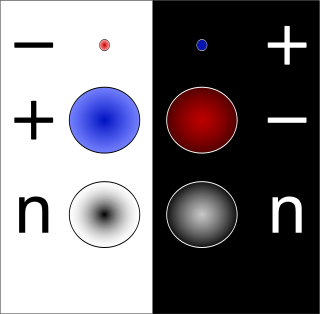
In particle physics, every type of particle of "ordinary" matter is associated with an antiparticle with the same mass but with opposite physical charges. For example, the antiparticle of the electron is the positron. While the electron has a negative electric charge, the positron has a positive electric charge, and is produced naturally in certain types of radioactive decay. The opposite is also true: the antiparticle of the positron is the electron.

Particle physics or high-energy physics is the study of fundamental particles and forces that constitute matter and radiation. The field also studies combinations of elementary particles up to the scale of protons and neutrons, while the study of combination of protons and neutrons is called nuclear physics.

The positron or antielectron is the particle with an electric charge of +1e, a spin of 1/2, and the same mass as an electron. It is the antiparticle of the electron. When a positron collides with an electron, annihilation occurs. If this collision occurs at low energies, it results in the production of two or more photons.

Cosmic rays or astroparticles are high-energy particles or clusters of particles that move through space at nearly the speed of light. They originate from the Sun, from outside of the Solar System in our own galaxy, and from distant galaxies. Upon impact with Earth's atmosphere, cosmic rays produce showers of secondary particles, some of which reach the surface, although the bulk are deflected off into space by the magnetosphere or the heliosphere.
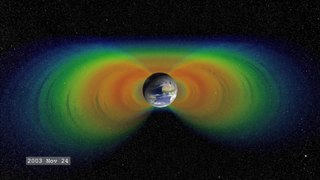
Van Allen radiation belt is a zone of energetic charged particles, most of which originate from the solar wind, that are captured by and held around a planet by that planet's magnetosphere. Earth has two such belts, and sometimes others may be temporarily created. The belts are named after James Van Allen, who is credited with their discovery.

The antiproton,
p
, is the antiparticle of the proton. Antiprotons are stable, but they are typically short-lived, since any collision with a proton will cause both particles to be annihilated in a burst of energy.
The BaBar experiment, or simply BaBar, is an international collaboration of more than 500 physicists and engineers studying the subatomic world at energies of approximately ten times the rest mass of a proton (~10 GeV). Its design was motivated by the investigation of charge-parity violation. BaBar is located at the SLAC National Accelerator Laboratory, which is operated by Stanford University for the Department of Energy in California.

ATLAS is the largest general-purpose particle detector experiment at the Large Hadron Collider (LHC), a particle accelerator at CERN in Switzerland. The experiment is designed to take advantage of the unprecedented energy available at the LHC and observe phenomena that involve highly massive particles which were not observable using earlier lower-energy accelerators. ATLAS was one of the two LHC experiments involved in the discovery of the Higgs boson in July 2012. It was also designed to search for evidence of theories of particle physics beyond the Standard Model.
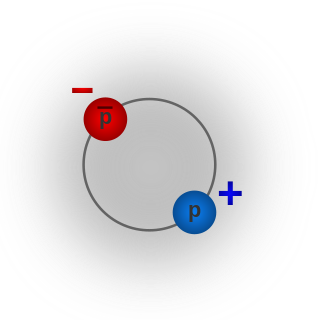
Protonium, also known as antiprotonic hydrogen, is a type of exotic atom in which a proton and an antiproton orbit each other. Since protonium is a bound system of a particle and its corresponding antiparticle, it is an example of a type of exotic atom called an onium.

PAMELA was a cosmic ray research module attached to an Earth orbiting satellite. PAMELA was launched on 15 June 2006 and was the first satellite-based experiment dedicated to the detection of cosmic rays, with a particular focus on their antimatter component, in the form of positrons and antiprotons. Other objectives included long-term monitoring of the solar modulation of cosmic rays, measurements of energetic particles from the Sun, high-energy particles in Earth's magnetosphere and Jovian electrons. It was also hoped that it may detect evidence of dark matter annihilation. PAMELA operations were terminated in 2016, as were the operations of the host-satellite Resurs-DK1. The experiment was a recognized CERN experiment (RE2B).
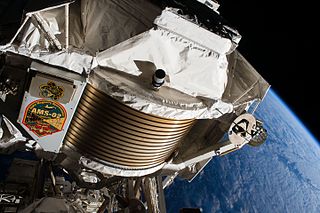
The Alpha Magnetic Spectrometer (AMS-02) is a particle physics experiment module that is mounted on the International Space Station (ISS). The experiment is a recognized CERN experiment (RE1). The module is a detector that measures antimatter in cosmic rays; this information is needed to understand the formation of the Universe and search for evidence of dark matter.
Astroparticle physics, also called particle astrophysics, is a branch of particle physics that studies elementary particles of astronomical origin and their relation to astrophysics and cosmology. It is a relatively new field of research emerging at the intersection of particle physics, astronomy, astrophysics, detector physics, relativity, solid state physics, and cosmology. Partly motivated by the discovery of neutrino oscillation, the field has undergone rapid development, both theoretically and experimentally, since the early 2000s.
The Particle Astrophysics Magnet Facility is a NASA project that was designed to investigate anti-matter. It consisted of a series of experiments which would culminate in an experiment launched in 1995 to be externally attached to the Freedom Space Station
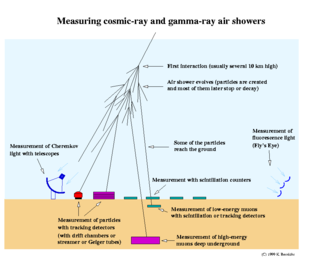
A cosmic-ray observatory is a scientific installation built to detect high-energy-particles coming from space called cosmic rays. This typically includes photons, electrons, protons, and some heavier nuclei, as well as antimatter particles. About 90% of cosmic rays are protons, 9% are alpha particles, and the remaining ~1% are other particles.
High-precision experiments could reveal small previously unseen differences between the behavior of matter and antimatter. This prospect is appealing to physicists because it may show that nature is not Lorentz symmetric.
General antiparticle spectrometer (GAPS) is a planned experiment that will use a high-altitude balloon flying in Antarctica to look for antideuteron particles from outer space cosmic rays, in an effort to search for dark matter. Anti-deuterons could perhaps be produced by the annihilation of hypothetical weakly interacting massive particles (WIMPs). The goal of the GAPS experiment is to capture anti-deuterons in a target material, to form an exotic atom in an excited state. The exotic atom would quickly decay, producing detectable X-rays energies with pion signature from nuclear annihilation.

The High Altitude Water Cherenkov Experiment or High Altitude Water Cherenkov Observatory is a gamma-ray and cosmic ray observatory located on the flanks of the Sierra Negra volcano in the Mexican state of Puebla at an altitude of 4100 meters, at 18°59′41″N97°18′30.6″W. HAWC is the successor to the Milagro gamma-ray observatory in New Mexico, which was also a gamma-ray observatory based around the principle of detecting gamma-rays indirectly using the water Cherenkov method.
Charles James "Chuck" Hailey is an experimental astrophysicist and Pupin Professor of Physics at Columbia University. He earned his BA in physics from Cornell University in 1977 and his PhD from Columbia in 1983, with a thesis entitled "The Development of an Imaging Gas Scintillation Proportional Counter for Use in X-ray Astronomy." He received tenure from Columbia University in 1995. Hailey's research focuses on high energy astrophysics and experimental particle physics. He is co-director of the Columbia Astrophysics Laboratory, where he works on gamma-ray and X-ray research.
Cosmic Ray Energetics and Mass (CREAM) is an experiment to determine the composition of cosmic rays up to the 1015 eV (also known as the "knee prospect") in the cosmic ray spectrum.












